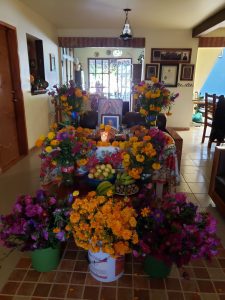What Is Dia De Los Muertos?
In Mexico, Dia De Muertos (the “los” is mostly used in the U.S), is a pre-hispanic Aztec tradition that took place on different dates. After the Spanish came, they incorporated their religion with this tradition, and thus came what we now celebrate on November 1st and 2nd. Traditions such as altar building and offerings were ancient traditions that carried over to this holiday. The Catrina has become a very popular icon and is often used to represent this day. While there is a queen of the underground, this particular Catrina was drawn up in 1910 by a Mexican political cartoonist named Jose Guadalupe Posada. This Holiday is now widely celebrated throughout Mexico and Latin America.
What does this holiday mean to you?
Christina: This holiday to me means the celebration of our loved ones that have passed and honoring their lives. Bringing together generations and continuing a tradition and carrying forth the lives of ancestors and loved ones.
Shirley: For me, it is a day to really sit down and honor your ancestors. To talk and reflect on their lives and how their actions led to you being where you are. You come together with family to talk and share stories and pass down your history. I think about them year-round, this day, we celebrate that they lived, instead of mourning that they are gone
Did you celebrate it growing up?
Christina: I wasn’t aware of this holiday until I was in my early teens. Growing up we didn’t celebrate a lot of the traditions in Mexican culture, it just wasn’t incorporated. I wish I had an answer to that question, but I’m sure my parents had some validity as to why. But now that I have kids of my own, I’m trying to change that and make sure they’re aware of their culture and express that appreciation. In doing so, building an ofrenda with him and giving him a history lesson on the meaning of Dia de los Muertos, I feel I’m excelling at what my upbringing did not.
Shirley: Not really, no. I knew about it because my mom would always talk about how my aunts would go and clean up graves and put out jarritos de leche for the kids. As we got older, my aunt would start sending us pan de muerto, each piece personalized with our names. So it wasn’t until I was older that I started questioning why we did not take part of these traditions. My mom let me know that when they arrived from Mexico, they had no community to continue these traditions with, so they stopped because it wasn’t “the American way”. She acknowledges that it was hard to let go. Religion played a part in it too, but that’s kind of a lengthy topic on how I feel about that. Haha. Now, we do small things here and there together, mainly focusing on building an altar for our loved ones since we can’t go to Mexico every year to partake in the tradition of cleaning and decorating the graves.
What traditions do you carry on, or what traditions have you created?
Christina: I’ve incorporated what I consider a ‘year round ofrenda,’ which is an altar dedicated to our friends and family who have passed. Even though Dia de los Muertos is important, I also believe that keeping their memories alive every day is important. So I’ve dedicated a whole table specifically for this reason. I’ve adorned it with marigolds and various other flowers and have kept it free of anything other than what I’ve intended it for.
Shirley: Well, this holiday is celebrated differently all across Mexico (and across Latin America, including parts of the Caribbean). My family (from what has been shared) gets together to clean up the graves and decorate. Afterward, they drop flores de cempasuchil to make a path for the spirits to follow home. They make altars that include pictures and food favorites of those who have moved on. So the one tradition we have been able to keep up with is the altar. I can’t have food out, or the dog and cat will get to it, so I’ll do drinks and fruits. My son is really getting into sugar skulls, so I have to learn how to make them. I’ve made it an effort to start going to events or parades where we can celebrate with the community, so I guess that is one tradition we are starting.
Thoughts on Dia de Muertos in the U.S.? Appreciation or Appropriation?
Christina: This is a mouthful! I’ll try to explain why I feel there is misappropriation within the U.S. I feel that it has become synonymous with Halloween since both fall on the same day, but Dia de los Muertos continues on until November 2nd. They’re two separate holidays that come from separate cultures. Within my household, I celebrate both individually, as well as decorate for each. Which also, can be a hindrance, since I don’t and can’t find everything I want specifically for Dia de los Muertos or Halloween for that matter. When it comes to decorating or finding things that are specific to this holiday, can be frustrating. If someone wants to participate in this celebration, just research events in your community and incorporate things within your home.
Shirley: I definitely feel that Dia De Muertos has been appropriated in the U.S! You’ll see Catrina costumes for sale at retail stores, you’ll see sugar skulls used to advertise for restaurant specials, and so on and so forth. A Holiday that brings reverence and respect for our loved ones who have passed has become a cash cow for retailers across the country. This holiday is NOT “Mexican Halloween” and it shouldn’t be treated as such. With that being said, you most definitely can appreciate the holiday by learning about what it means. Look up traditions from different places that celebrate the holiday. Support artists who are not benefitting from another culture. Look up events in your area and attend the celebrations! Nuestras Raices in Flagstaff puts on cultural displays at the Northern Arizona Museum, filled with altares and much much more.
A beautiful representation of what an ofrenda can look like, is shown below. Honoring your family includes placing favorite foods or drinks on the altar and incorporating marigolds, which attract the souls of the dead and allowing the souls of our loved ones to cross over. This holiday amongst the Latin communities is a treasured time but it’s not inclusive and we implore those interested to indulge in this holiday and research the beauty of honoring and respecting our loved ones that have passed.










